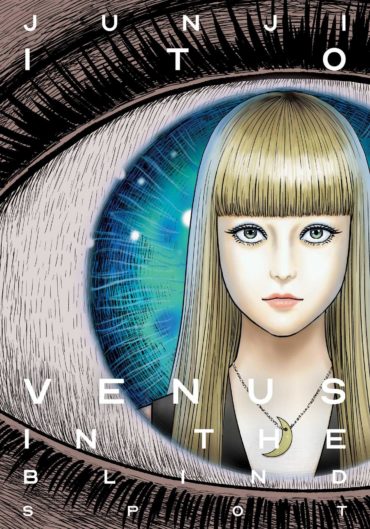Venus in the Blind Spot Review
WARNING: This is a horror manga and as such some readers may find the content disturbing.
VIZ once again presents us with another collection of Junji Ito’s short works, and there is a real mixture in this collection: some new tales of horror, some previously released but now in colour, some based on the work of other writers, and one autobiographical tale.
The opening story, “Billions Alone”, is one of Ito’s body horror standards, revolving around a hikikomori named Michio who re-encounters the woman who was the only one who defended him when they were at school. At the same time, a series of killings takes place in which multiple people have been found naked with their bodies sown together with fishing lines. The first seen is of two people, but the bodies rapidly mount up, including one twisted scene of sewn bodies being displayed as horrific decorations on Christmas trees. At the same time, a strange radio programme airs, encouraging the “billions alone” to become more friendly with each other.
After that are two adaptations of stories by mystery writer Edogawa Ranpo – a man who has influenced more than one manga as it happens. For example, his novel The Fiend with Twenty Faces is where the gentleman thief ’20 Faces’ comes from, as in the secret identity of Akira Ijyuin in CLAMP’s Man of Many Faces and CLAMP School Detectives. The stories Ito tells are a reimagining of Ranpo’s short “The Human Chair”, in which a woman novelist becomes convinced that there is a man hiding in her fancy writing chair, and “An Unearthly Love”, about a pair of newlyweds where the wife learns her husband is having an affair with someone… or rather something.
The title story, “Venus in the Blind Spot”, concerns a girl, Mariko Shono, who is a UFO enthusiast. When her male friends come and see her, however, she appears to turn invisible before their eyes. The narrator, Sano, explains of a scuffle between members of a UFO society set up by Mariko’s father, a doctor, after a new member claims to have been abducted by aliens, and since then, he has been unable to see Mariko up close, leading to panic that Mariko is perhaps really an alien.
Next is “The Licking Woman”, another body horror tale, this time concerning a woman with a vile tongue who licks people and poisons them to death. A woman, Miko, becomes obsessed with stopping her after her fiancé and dog are both killed by the woman. This leads her to go as far as covering herself with deadly cyanide in order to stop her. After this is an autobiographical tale, “Master Umezz and Me”, in which Ito talks about his love for the horror mangaka Kazuo Umezz (The Drifting Classroom) and how Ito was approached to make a manga adaptation of his film Mother.
“How Love Came to Professor Kirida” is another adaptation, this being a retelling of “How Love Came to Professor Guildea” by Robert Hichens, although it should be mentioned that in the manga the title is incorrectly rendered as “How Love Come to Professor Guildea”. The tale revolves around a priest and the titular misanthropic writer who hates love and whose rejection of the works of a wannabe female writer drive her to try and drown herself. This leads to Kirida being haunted by some kind of spirit.
Afterward is “The Enigma of Amigara Fault”, a short that has been previously released in English and concerns the discovery of people-shaped holes in a cliff face. This version does however contain some colour pages. Next is “The Sad Tale of the Principle Post”, another very short story that has been previously been released, but this time entirely in colour. Lastly is “Keepsake”, about a man who discovers that his dead wife has given birth in her grave.
As with all short story collections, the quality of each story varies. Indeed, in the case of this book, even the translation varies, as the previously released “Amigara Fault” and “Principle Post” have translation by Yuji Oniki, while the rest of the manga is translated and adapted by Jocelyne Allen.
Personally, I prefer Ito’s original stories rather than his adaptations. “Master Umezz & Me” gives an insight into his influences and also into more of Umezz’s work. The body horror stories “Billions Alone” and “The Licking Woman” are both rather gruesome affairs, but both are gripping because they look so vile and horrific. Ito has a great gift for drawing the reader into seeing something that is so shocking. The one that sticks in my head the most is the scene in “Billions Alone” at Christmas, with sewn-up bodies decorating not just Christmas trees, but an entire park and the surrounding buildings. This is partly because you are looking at something so shocking, but there is also the element of just trying to figure out who could have done this, and to so many people.
While I am glad to see some stories in colour in this collection, part of me is annoyed that this book is not full of entirely new material. The stories picked are good, but it would have been better to have included stories that were all brand-new to English readers.
However, Venus in the Blind Spot is still a thrilling, gripping read, if your stomach can stand some of the more grizzly aspects of Ito’s horror.


